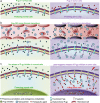Carbon nano-onion-mediated dual targeting of P-selectin and P-glycoprotein to overcome cancer drug resistance
- PMID: 33436622
- PMCID: PMC7803730
- DOI: 10.1038/s41467-020-20588-0
Carbon nano-onion-mediated dual targeting of P-selectin and P-glycoprotein to overcome cancer drug resistance
Abstract
The transmembrane P-glycoprotein (P-gp) pumps that efflux drugs are a major mechanism of cancer drug resistance. They are also important in protecting normal tissue cells from poisonous xenobiotics and endogenous metabolites. Here, we report a fucoidan-decorated silica-carbon nano-onion (FSCNO) hybrid nanoparticle that targets tumor vasculature to specifically release P-gp inhibitor and anticancer drug into tumor cells. The tumor vasculature targeting capability of the nanoparticle is demonstrated using multiple models. Moreover, we reveal the superior light absorption property of nano-onion in the near infrared region (NIR), which enables triggered drug release from the nanoparticle at a low NIR power. The released inhibitor selectively binds to P-gp pumps and disables their function, which improves the bioavailability of anticancer drug inside the cells. Furthermore, free P-gp inhibitor significantly increases the systemic toxicity of a chemotherapy drug, which can be resolved by delivering them with FSCNO nanoparticles in combination with a short low-power NIR laser irradiation.
Conflict of interest statement
The authors declare no competing interests.
Figures







Similar articles
-
Near-infrared light switching nitric oxide nanoemitter for triple-combination therapy of multidrug resistant cancer.Acta Biomater. 2019 Dec;100:365-377. doi: 10.1016/j.actbio.2019.10.002. Epub 2019 Oct 4. Acta Biomater. 2019. PMID: 31586724
-
The use of nanoparticle-mediated targeted gene silencing and drug delivery to overcome tumor drug resistance.Biomaterials. 2010 Jan;31(2):358-65. doi: 10.1016/j.biomaterials.2009.09.048. Epub 2009 Oct 1. Biomaterials. 2010. PMID: 19800114 Free PMC article.
-
Targeted production of reactive oxygen species in mitochondria to overcome cancer drug resistance.Nat Commun. 2018 Feb 8;9(1):562. doi: 10.1038/s41467-018-02915-8. Nat Commun. 2018. PMID: 29422620 Free PMC article.
-
P-glycoprotein inhibition as a therapeutic approach for overcoming multidrug resistance in cancer: current status and future perspectives.Curr Cancer Drug Targets. 2013 Mar;13(3):326-46. doi: 10.2174/15680096113139990076. Curr Cancer Drug Targets. 2013. PMID: 23369096 Review.
-
Doxorubicin-loaded nanoparticles: new advances in breast cancer therapy.Anticancer Agents Med Chem. 2012 Nov;12(9):1058-70. doi: 10.2174/187152012803529646. Anticancer Agents Med Chem. 2012. PMID: 22339066 Review.
Cited by
-
Enhancing Paclitaxel Efficacy with Piperine-Paclitaxel Albumin Nanoparticles in Multidrug-Resistant Triple-Negative Breast Cancer by Inhibiting P-Glycoprotein.Pharmaceutics. 2023 Nov 30;15(12):2703. doi: 10.3390/pharmaceutics15122703. Pharmaceutics. 2023. PMID: 38140044 Free PMC article.
-
Recent advances in anti-multidrug resistance for nano-drug delivery system.Drug Deliv. 2022 Dec;29(1):1684-1697. doi: 10.1080/10717544.2022.2079771. Drug Deliv. 2022. PMID: 35616278 Free PMC article. Review.
-
Design, Synthesis, and Biological Evaluation of Marine Lissodendrins B Analogues as Modulators of ABCB1-Mediated Multidrug Resistance.Mar Drugs. 2023 May 20;21(5):314. doi: 10.3390/md21050314. Mar Drugs. 2023. PMID: 37233508 Free PMC article.
-
Targeting Selectins Mediated Biological Activities With Multivalent Probes.Front Chem. 2021 Dec 3;9:773027. doi: 10.3389/fchem.2021.773027. eCollection 2021. Front Chem. 2021. PMID: 34926401 Free PMC article. Review.
-
Nanoparticles as Physically- and Biochemically-Tuned Drug Formulations for Cancers Therapy.Cancers (Basel). 2022 May 17;14(10):2473. doi: 10.3390/cancers14102473. Cancers (Basel). 2022. PMID: 35626078 Free PMC article. Review.
References
Publication types
MeSH terms
Substances
Grants and funding
LinkOut - more resources
Full Text Sources
Other Literature Sources
Medical
Molecular Biology Databases
Miscellaneous

